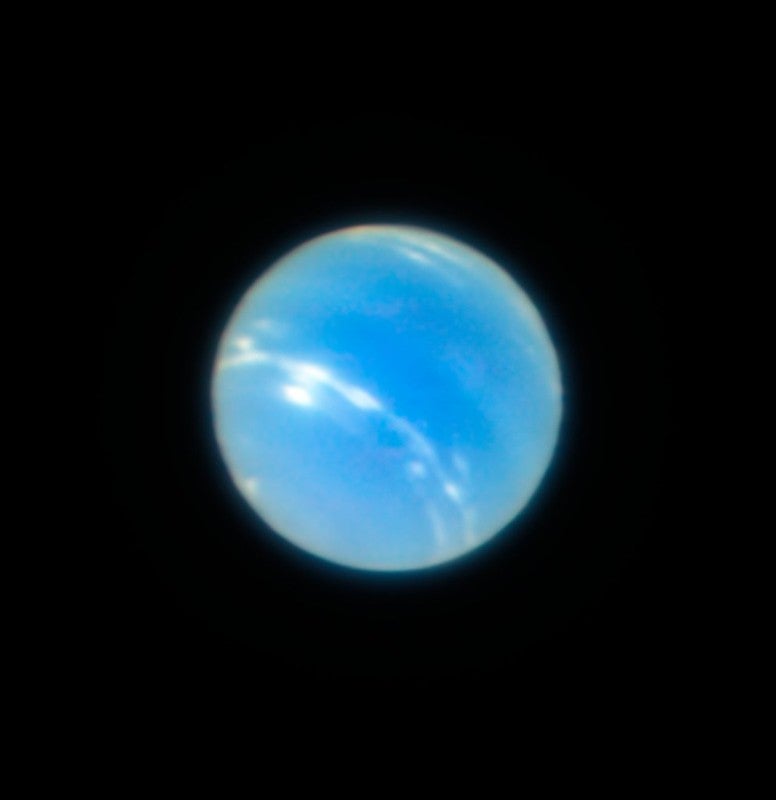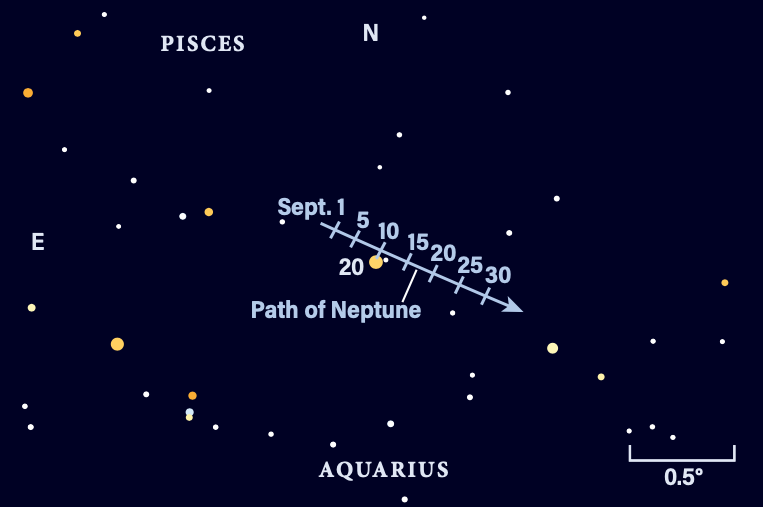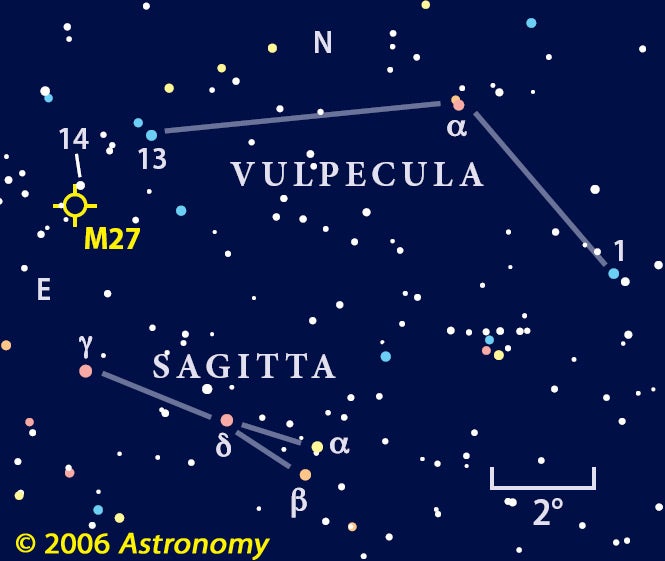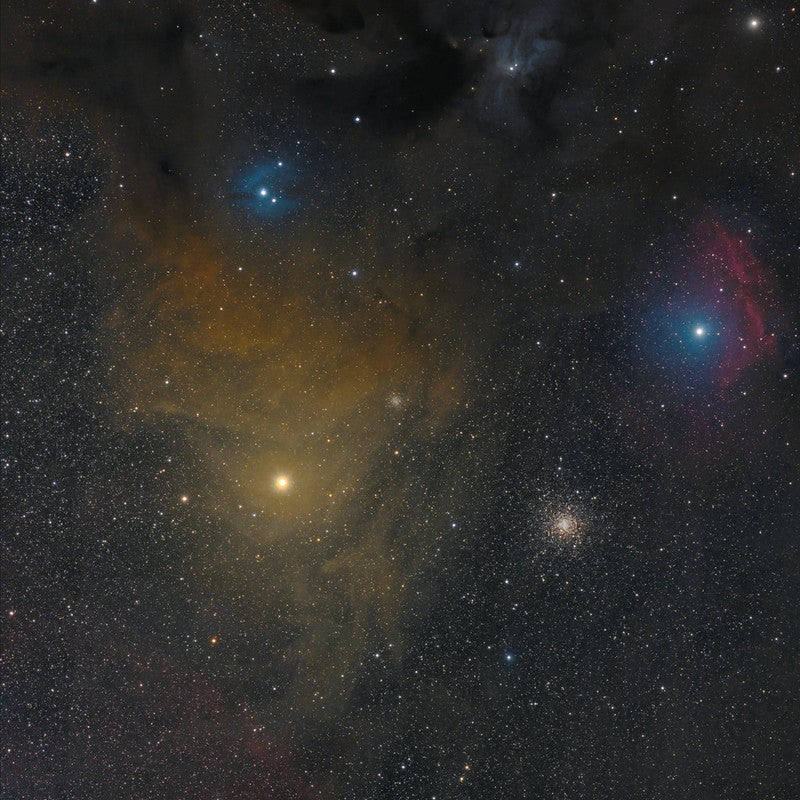
Friday, September 15
Saturn’s largest and brightest moon, Titan, is passing south of the ringed planet overnight. You can find Saturn as soon as the sky grows dark after sunset, glowing a soft magnitude 0.5 in Aquarius. By two hours after sunset, the planet is just over 25° high in the southeast, some 19.5° above 1st-magnitude Fomalhaut in Piscis Austrinus.
Zoom in on Saturn with a telescope to first view its gorgeous ring system, now tilted toward Earth by about 10°. The rings stretch 42″, while the disk of the planet spans nearly 20″. Arrayed around the planet are several moons — Titan is the brightest, glowing around magnitude 8.5. It’s located southeast of Saturn in the early evening, very slowly moving west. It will pass due south of the planet during daylight hours on the 16th.
Other moons visible include 10th-magnitude Tethys, Dione, and Rhea. The first two sit close to the planet’s disk, just west of the limb and south of the rings. They continue moving west overnight. Rhea lies far to the east, nearly 1.5′ from of the center of the planet; it appears to stay in the same location all night.
Careful observers might spot Mimas and its shadow crossing in front of the disk from about 2 A.M. EDT on the 16th (still late on the 15th in western time zones) to shortly before 4 A.M. EDT on the 16th. The moon and its shadow are small and faint compared to the disk, so high magnification and steady seeing will up your chances — or you can try to capture the event photographically or using high-speed video.
Sunrise: 6:41 A.M.
Sunset: 7:09 P.M.
Moonrise: 7:06 A.M.
Moonset: 7:38 P.M.
Moon Phase: New
*Times for sunrise, sunset, moonrise, and moonset are given in local time from 40° N 90° W. The Moon’s illumination is given at 12 P.M. local time from the same location.
Saturday, September 16
The Moon passes 0.7° north of Mars at 3 P.M. EDT. From the eastern half of the U.S., the Moon passes entirely in front of Mars in an event called an occultation that occurs in daylight around the same time. Experienced observers who want to catch the event should do so carefully — try setting up and calibrating your telescope’s go-to system early in the morning before sunrise so you can ensure it’s tracking properly, and never look through the eyepiece or finder scope while it is moving. Even a brief, accidental glimpse of the Sun could seriously and permanently damage your eyes.
For much easier — and safer — viewing, the pair hangs about 8° high in the west at sunset. They are now roughly 2° apart, with the Moon located to Mars’ upper left (east). Our satellite is a mere 4-percent-lit waxing crescent — can you see the delicate sliver of the eastern limb directly lit by the Sun? You might also notice that the dark face still in shadow is visible, thanks to a phenomenon called earthshine. This occurs when sunlight bounces off Earth and illuminates the portion of the Moon not under direct sunlight. Binoculars or a telescope can help bring out detail on the thin crescent before it sets.
Just west of the Moon is Mars, glowing at magnitude 1.7. Through a telescope, it appears fully lit and spans just 4″. The Red Planet now lies some 2.5 astronomical units from Earth (1 astronomical unit, or AU, is the average Earth-Sun distance).
As the region sinks, you might see 1st-magnitude Spica appear about 10° to the upper left of the Moon and Mars as the sky grows darker. And some 30° above them is brighter Arcturus in Boötes, shining at magnitude 0.
Sunrise: 6:42 A.M.
Sunset: 7:07 P.M.
Moonrise: 8:06 A.M.
Moonset: 7:57 P.M.
Moon Phase: Waxing crescent (3%)

Sunday, September 17
Neptune reaches opposition at 7 A.M. EDT. Now is the best time to view the most distant planet in our solar system, which currently lies nearly 29 AU from Earth. The planet is rising in the east amid the stars of Pisces at sunset, so wait an hour or two for the sky to darken and the region to climb out of the turbulent air near the horizon. At opposition Neptune rises around sunset and sets around sunrise. This gives you a wide range of viewing opportunities that will continue for weeks to come.
Around 10 P.M. local daylight time, Neptune is 30° high in the east, hanging just beneath the Circlet asterism in Pisces. You’ll find it through binoculars or with a telescope some 4.7° south-southeast of Lambda (λ) Piscium. Tonight, the ice giant sits a mere 10′ due west of a 5th-magnitude field star, HD 15313 (also cataloged as HIP 11375). Through your optics, Neptune will simply look like a “flat” star or tiny disk just 2″ wide. In reality, it is a giant world some 17 times the mass of Earth and almost 4 times as wide as our planet.
Venus reaches its greatest illuminated extent at 10 A.M. EDT, when it is magnitude –4.8. If you’re still up after a night of Neptune observing, you’ll see Venus rise in the east about three hours before the Sun, located in southeastern Cancer near the constellation’s 4th-magnitude alpha star. The bright planet hangs some 10° below the naked-eye Beehive Cluster (M44), offering stunning views before twilight brightens the sky too much.
Sunrise: 6:43 A.M.
Sunset: 7:06 P.M.
Moonrise: 9:08 A.M.
Moonset: 8:18 P.M.
Moon Phase: Waxing crescent (6%)
Monday, September 18
An early-morning occultation of Ganymede by its parent world Jupiter will greet observers in the eastern half of the U.S. today.
The event kicks off shortly before 12:30 A.M. EDT, so note this is still late on the 17th in all other time zones. At that time, Jupiter is some 45° high in the east, located in southeastern Aries. It’s the brightest object in the region, its magnitude –2.7 light outshining the constellation’s faint stars. Train your telescope on Jupiter around 12:20 A.M. EDT to ensure you don’t miss the start, as bright Ganymede approaches the planet’s northern limb from the west. The moon should start to disappear behind the limb just a few minutes later — but slowly, thanks to its size combined with the shallow angle at which we’re viewing the event.
It takes about an hour for Ganymede to reappear, slipping out from behind the disk at 1:22 A.M. EDT. The whole sequence is best seen from the East Coast and the Midwest, as the planet will be lower in the sky for observers farther west (though if you can catch it, particularly from a higher elevation, do try). Remember that the farther west your time zone, the more likely it is that this event will occur late on the 17th, rather than early on the 18th.
As the hours progress into the morning of the 18th, there’s another event to watch out for: While Ganymede pulls away to the east, Io is approaching from the east for a transit. Its shadow appears on the cloud tops first, moving inward from the eastern limb around 5:10 A.M. EDT. Io follows suit, passing in front of the disk starting around 6:10 EDT, shortly before sunrise on the East Coast. Now those in western time zones have an advantage, as they can watch the shadow and moon cross the planet. The shadow disappears just before 6:15 A.M. CDT, not long before sunrise in the Midwest. The moon continues its journey, finally moving off the disk around 6:15 A.M. MDT.
Sunrise: 6:43 A.M.
Sunset: 7:04 P.M.
Moonrise: 10:11 A.M.
Moonset: 8:42 P.M.
Moon Phase: Waxing crescent (12%)
Tuesday, September 19
Although Comet Nishimura has left our skies, there are plenty of other comets to enjoy, albeit ones that require a telescope to see. One is Comet 103P/Hartley 2, now rising late at night in the constellation Auriga. You can catch it overnight starting around midnight and continuing into the early-morning hours, climbing highest in the northeast in the few hours before dawn.
Now about 10th magnitude, Hartley 2 is passing just 2° southeast of 3rd-magnitude Eta (η) Aurigae, putting it about 6.5° due south of the bright (magnitude 0.1) star Capella. Today the comet also lies about 2° west of the open cluster NGC 1857, a 7th-magnitude grouping of young stars covering about 4.5′ of sky. A medium field of view should show both, making for a great scene to photograph if you’re able. Also nearby — about 3.4° southwest of NGC 1857 — is another open cluster, NGC 1778. This group of stars covers about the same area of sky but is a bit fainter, around magnitude 7.7.
Hartley 2 is still brightening and could reach magnitude 7.5 next month.
Sunrise: 6:44 A.M.
Sunset: 7:02 P.M.
Moonrise: 11:17 A.M.
Moonset: 9:11 P.M.
Moon Phase: Waxing crescent (19%)

Wednesday, September 20
High in the south this evening is the constellation Vulpecula the Fox. A few hours after sunset, it lies directly above Aquila the Eagle, whose bright star Altair is part of the famous Summer Triangle asterism. The small constellation Sagitta the Arrow is sandwiched between them.
Vulpecula houses a particularly famous deep-sky wonder: the Dumbbell Nebula (M27). This beautiful planetary nebula is the result of an aging star blowing away its outer layers, then lighting up the thrown-off gas from the inside out. The Dumbbell sits about 2° southeast of 13 Vulpeculae, a 5th-magnitude star. Alternatively, you can use magnitude 3.5 Gamma (γ) Sagittae to find it, as M27 is 3.2° due north of this star.
Even through 10x binoculars, the Dumbbell should look noticeably rectangular. Bump up the magnification for a bit more detail. The Dumbbell shines at magnitude 7.3 and is fairly large (about 8′ long along its long axis), making it a great object even for smaller scopes. See if you can spot the two slightly brighter regions of nebulosity at either end, which give the nebula its bowtie or dumbbell shape.
Sunrise: 6:45 A.M.
Sunset: 7:01 P.M.
Moonrise: 12:25 P.M.
Moonset: 9:46 P.M.
Moon Phase: Waxing crescent (28%)

Thursday, September 21
The Moon passes 0.9° north of Antares at 4 A.M. EDT, though neither object is visible at that time. Instead, look south an hour after sunset to see the two now nearly 9° apart. In fact, the Moon has passed out of Scorpius — which houses Antares — and now resides in southern Ophiuchus, to Scorpius’ east. Unlike earlier in the week, Luna is now a 42-percent-lit crescent, quickly waxing toward First Quarter, which it will reach tomorrow.
But let’s focus on Antares, the bright, glowing red heart of the Scorpion. This 1st-magnitude red giant lies near the rich globular cluster M4, just 1.3° to Antares’ west. At magnitude 5.6, this cluster can be glimpsed with the naked eye under good skies; it spans just over half a degree and many of its stars can be resolved even in a small (4-inch) scope. It’s not too difficult to capture stunning images of the cluster with Antares nearby, and photographs can also pick up the nebulosity around Antares, cataloged as IC 4606. The light comes from ionized hydrogen gas, which is energized by the star so that it glows.
Slightly closer to Antares (just 40′ to its northwest) is another globular cluster, NGC 6144. This grouping is fainter and much more compact than M4. NGC 6144 covers just 10′ of sky and shining a fainter magnitude 9.1. Deep astrophotos show it embedded within the glow of the hydrogen gas lit by Antares.
Sunrise: 6:46 A.M.
Sunset: 6:59 P.M.
Moonrise: 1:35 P.M.
Moonset: 10:30 P.M.
Moon Phase: Waxing crescent (38%)
Friday, September 22
Mercury reaches greatest western elongation of 18° at 9 A.M. EDT. The small planet now appears in the predawn sky with Venus.
You’ll find Mercury in Leo, situated near the Lion’s back half and rising about an hour and a half before the Sun. An hour before sunrise, Mercury is 5° high and climbing, hanging below and just to the left of the bright star Regulus. The planet shines at –0.3, about a full magnitude brighter than the magnitude 1.4 star. Venus, meanwhile, still blazes at magnitude –4.8, but not for long — within two days, it will dim just slightly to magnitude –4.7 (admittedly a change that is indistinguishable to the eye). The brighter planet remains in Cancer, at the western end of an east-west line with Mercury at the eastern end and Regulus between the two planets.
Through a telescope, Mercury now spans 7″ and is 48 percent lit. By contrast, Venus appears huge — 36″ across — but now just 30 percent lit. Venus is both physically larger than Mercury and also closer to Earth: Venus lies 0.46 AU from us, while Mercury is 0.95 AU from Earth.
First Quarter Moon occurs this afternoon at 3:32 P.M. EDT.
Sunrise: 6: 47 A.M.
Sunset: 6:57 P.M.
Moonrise: 2:40 P.M.
Moonset: 11:26 P.M.
Moon Phase: Waxing crescent (49%)

Sky This Week is brought to you in part by Celestron.









